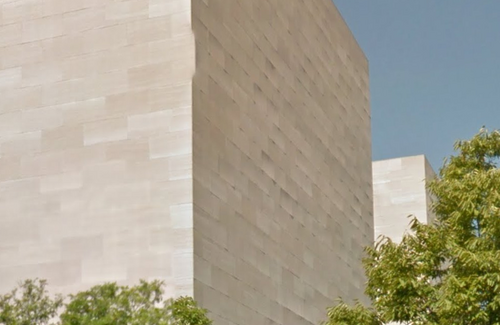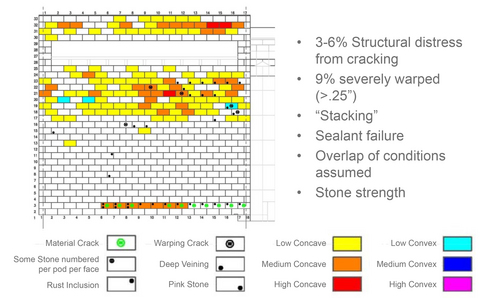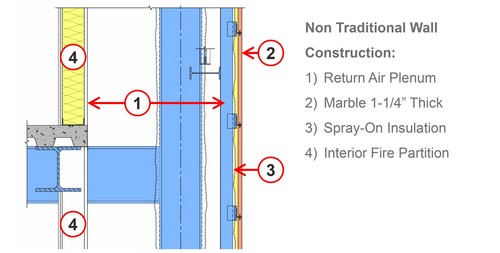The Air and Space Museum needs a new skin
In the four decades after it opened, the National Air and Space Museum has become one of Washington’s most well-loved attractions. Its building hasn’t aged so well.
The window walls are outdated, skylights leak, the mechanical systems are dying, and the terraces are leaking into the basement car storage. But much worse than that, the stones that clad the building are bowing and cracking, which threaten to make it uninhabitable.
Usually, there’s nothing wrong with getting wrinkly at 40, but here, the 12,000 stone panels are pretty much the only thing keeping water out of the building. When they deform, they expose the building to more and bigger leaks. They could also break and fall onto someone.
We think of stone as unfailingly solid. But, like in most buildings built after 1900, the stones at the Air and Space Museum form a veneer that carries no weight. This approach has worked quite well in most cases, but if the stones are too thin, or installed the wrong way, they can deteriorate.
When thin stones fail
The museum’s stones are 5 feet long, 2½ feet high, but only 1¼ inches thick. Beginning in the 1950s, engineers and architects tried to apply stone as thinly as possible to make buildings more cost-efficient.
Things went well for denser stones like granite and on buildings in warmer climates. But beginning in the 1970s, spectacular failures started to occur when soft marble covered a building in a cold climate, like Finlandia Hall in Helsinki or the Standard Oil Building in Chicago.
The stones started bowing due to a phenomenon called “thermal hysteresis.”
Imagine a slab of stone sitting in the sun. One side gets warm from the sunshine, while the other does not. The sunny side expands and contracts differently from the other. If the stone is too thin, the flexing can damage the crystalline structure.
Stone comes to the National Mall
The Air and Space Museum is clad in a stone called “Tennessee pink marble,” although it’s technically not marble, but a particularly crystallized form of limestone.
John Russell Pope introduced the stone to the National Mall with his 1941 National Gallery of Art. The warm color and faintly glittering texture was a welcome alternative to icy marble, dull limestone, and harsh granite. Because the National Air and Space Museum was across from the National Gallery, the Commission of Fine Arts pushed its architect, Gyo Obata, to match it.
But Pope used stones four to eight inches thick and installed them in a heavy and redundant way. IM Pei’s stonework on the 1978 East Wing also had serious problems, but those stones were 3 inches thick and the problems primarily came from the way the stones hung on the building, which the Gallery was able to fix.
That will not be possible at the Air and Space Museum.
Too thin is just the beginning
The panels are pinned together end to end through holes drilled through the stone. As the panels warp at different rates, stainless steel rods apply enormous pressure to an extremely thin layer of stone. The brittle stone is liable to crack and even shed pieces.
The stones also sit on metal rails connected directly to the steel frame, so unlike with the National Gallery buildings, they’re subject to the frame’s motion. Already by the 1980s the Smithsonian had to widen the joints between the stones to reduce damage.
As the stone cracks, an inner cavity opens to the elements. Normal buildings have a membrane or second wall to prevent moisture from moving through the outer walls. Here, the only protection is foam insulation sprayed onto the inner face of the stone.
Finally, between the stones and walls of the exhibition halls is a large open space that carries used air back to the ventilation system. This means that the thin stones are the only thing between inside and outside. Ironically, reconstruction architect Larry Barr remarked that the constant airflow was probably the only reason there wasn’t severe water damage or a mold problem. Moisture could simply never accumulate with the continuous flow of dryer air.
Some solutions are obvious, others require tough choices
The building needs a new facade, new windows, new equipment, and repairs to the terraces. You shouldn’t have to renovate a building, let alone a monumental one so soon, but the renovation offers the opportunity to correct 40-year-old mistakes and build for at least another hundred.
In the 1970s, inflation encouraged cost-cutting and buildings were adding elaborate mechanical systems long before their performance was understood. Sustainability was not yet a concern for architects. The museum, which had stalled for two decades, was then rushed to be ready for the 1976 United States Bicentennial and opened days before the 4th of July.
But building technology has improved a lot, so there is a silver lining. Fixing a relatively typical problem like the terrace waterproofing affords the opportunity to replace it with more proven systems, brush up the planting, and improve circulation around the site.
Much better glass technology including durable films to block unwanted radiation, newer seals, and better insulation would make for a better experience on cold days and muggy afternoons. The design team is even considering installing solar panels onto the roof, reducing carbon footprint and partially shading some of the skylights.
Other projects, such as redesigning the entrance for security purposes, offers the opportunity to make the building’s entrance more engaging. A similar level of attention could be paid to the Independence Avenue side of the museum, which stands out as particularly pedestrian-unfriendly.
The big decision is how to replace the stone and its supporting system. The museum asked Quinn Evans Architects to prepare for a reconstruction of the exterior, in four options: thicker Tennessee stone, sturdier pink granite, a ceramic system, or titanium. The latter two would bring new materials to the Mall and disrupt the match between this and the National Gallery, but would be more resilient and arguably interpret the building’s content better than stone.
The four options are deceptive, because of the wide range of textures possible with each material. Titanium can come in flat, smooth panels, or it can be scalier, like the titanium used on the Guggenheim Bilbao. Ceramic systems, too, can take a wide range of textures and forms. The options go beyond just copying the 2.5’ by 5’ stones as the rendering above suggests.
In any event, it makes little sense to fret over preserving the architecture. It is not a universally loved building. In a chat about America’s landmarks, Stanley Tigerman characterized it as “not even architecturally interesting,” pointing out that the building’s content occupies a more prominent role in the memory of Americans than the architecture itself
Perhaps a little bit more ambition and thought can mean we needn’t repeat this renovation in 2055.






